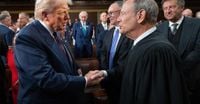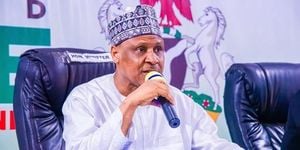The U.S. Supreme Court is poised to deliver a landmark decision that could dramatically redefine the balance of power in Washington, as it weighs a series of legal battles stemming from President Donald Trump’s assertive use of executive authority during his second term. From sweeping tariffs on foreign goods to mass firings of federal watchdogs, the Trump administration’s actions have ignited fierce debate about the limits of presidential power and the future of American democracy.
At the heart of the controversy is the Supreme Court’s fast-tracked review of Trump’s tariffs, which were imposed on nearly 100 countries under the International Emergency Economic Powers Act (IEEPA). According to The Atlantic, Trump’s administration levied tariffs as high as 50%, arguing that such measures were essential for national security and economic stability. However, a federal appeals court ruled 7-4 in early September 2025 that the IEEPA, passed in 1977, does not explicitly mention tariffs, duties, or taxes, and that the power to tax rests with Congress. The court’s decision, currently stayed until October 14, 2025, casts doubt on the legality of Trump’s signature economic policy.
The stakes are high, not just for the U.S. economy but for the very structure of government. As Paul Rosenzweig wrote in The Atlantic, “How the conservative-dominated Supreme Court responds to that ruling... will be crucial, both for the economy and the question of presidential authority generally.” If the justices side with Trump, it could signal a seismic shift in the constitutional system of checks and balances, potentially granting the executive branch unprecedented leeway. If they rule against him, it would mark the first significant judicial check on Trump’s power in his second term.
The Trump administration has mounted what some critics call the “Chicken Little Defense,” warning of catastrophic economic consequences if the tariffs are revoked. Treasury Secretary Scott Bessent has claimed the U.S. government could be forced to refund up to $1 trillion to importers—a scenario Trump himself has described as a “total disaster” for the nation. Yet legal analysts, such as Andrew C. McCarthy in National Review, argue that these dire predictions should not influence the Court’s constitutional reasoning. The appeals court’s split decision, with three judges in the majority conceding that the IEEPA allows for regulation of imports but objecting to the breadth of Trump’s tariffs, leaves a narrow path for the administration to prevail.
Observers are watching closely to see whether the Supreme Court will apply the same “major questions doctrine” it used in 2023 to strike down President Joe Biden’s student loan forgiveness program. As Reason magazine’s Eric Boehm noted, the doctrine holds that on issues of “vast economic and political significance,” the executive may only act with clear congressional authorization. The outcome will test whether this principle is applied consistently, regardless of the president’s party, or whether the Court finds “yet another escape hatch for Trump,” as Matt Ford wrote in The New Republic.
While the tariff case looms large, it is only one front in a broader campaign by the Trump administration to consolidate executive power. In February 2025, Cathy Harris, a member of the Merit Systems Protection Board (MSPB), received a terse email from the presidential personnel office: “Thank you for your service. You know, you’re fired, basically.” As reported by NPR, Harris’s term was not set to expire until 2028, and federal law stipulates that board members can only be dismissed for cause, such as inefficiency or misconduct. Nevertheless, the Trump administration removed her, prompting Harris to sue for reinstatement. Although she was briefly returned to her post twice, the Supreme Court issued an emergency order in late May 2025 allowing her firing to stand while litigation continues.
The MSPB, created by Congress in 1978, is designed to protect federal employees from management abuses and is staffed by administrative judges and a bipartisan board. Harris warned that the president’s ability to remove board members at will could undermine the board’s independence and, by extension, the integrity of the federal workforce. “If you know that the president can fire the board members at any time for no reason at all, is that going to impact the board members’ decision-making? I hope it wouldn’t, but I think it could,” she told NPR.
The Supreme Court’s conservative majority offered a glimpse into its thinking, writing in its emergency order: “Because the Constitution vests the executive power in the President, see Art. II, §1, cl. 1, he may remove without cause executive officers who exercise that power on his behalf, subject to narrow exceptions.” Lawyers close to the Trump administration, such as James Burnham, believe this interpretation gives the president sweeping authority over the executive branch. “Anyone who is wielding his power, who’s wielding derivative executive power that comes from the president, needs to be removable at will,” Burnham explained to NPR. “If they have for-cause protections, then they basically cannot be fully and properly supervised.”
Trump’s assertiveness has extended far beyond the MSPB. The administration has targeted other independent agencies, including the Federal Trade Commission, the Equal Employment Opportunity Commission, and the National Labor Relations Board, as well as inspectors general tasked with investigating waste, fraud, and abuse. The Office of Special Counsel, established nearly 50 years ago to protect whistleblowers, has also lost its independence after Biden-appointed Special Counsel Hampton Dellinger was fired by Trump in February 2025. “At the end of the day, that office is run by a single person... And that person now is at the beck and call of the president of the United States,” Dellinger said. “So it can no longer be called independent, and I don’t believe... it can still be considered a safe place for whistleblowers to go to.”
These developments have alarmed former federal officials and legal scholars who fear a return to the “spoils system” of political patronage that dominated the 19th century. Raymond Limon, a veteran federal employment attorney and former MSPB member, told NPR, “Authoritarianism 101, you know, is number one, go after the watchdogs.” He worries that Trump’s moves threaten the merit-based, professional civil service that has underpinned American governance for more than a century.
Justice Sonia Sotomayor, speaking at New York Law School on September 16, 2025, underscored the broader stakes of the moment. “Do we understand what the difference is between a king and a president?” she asked, highlighting the urgent need for Americans to grasp the principles of democratic institutions, individual rights, and the rule of law. Her warning comes as President Trump’s expansive interpretation of executive power faces its most consequential test yet before the nation’s highest court.
As the Supreme Court prepares to rule, the nation watches—wondering whether the justices will reinforce the constitutional guardrails that separate a president from a king, or chart a new course that could alter the American system of government for generations to come.






